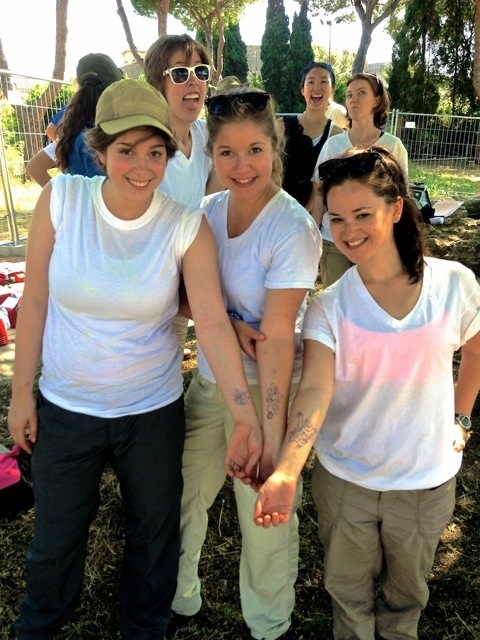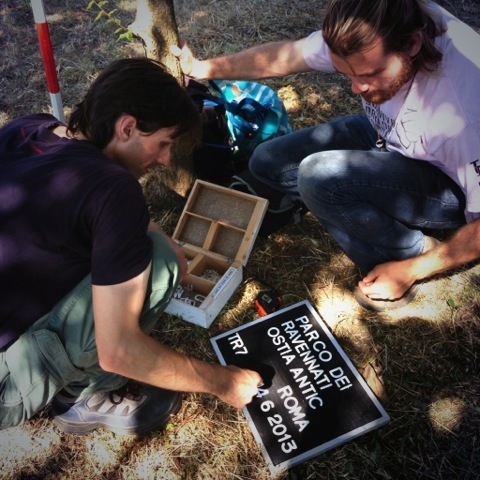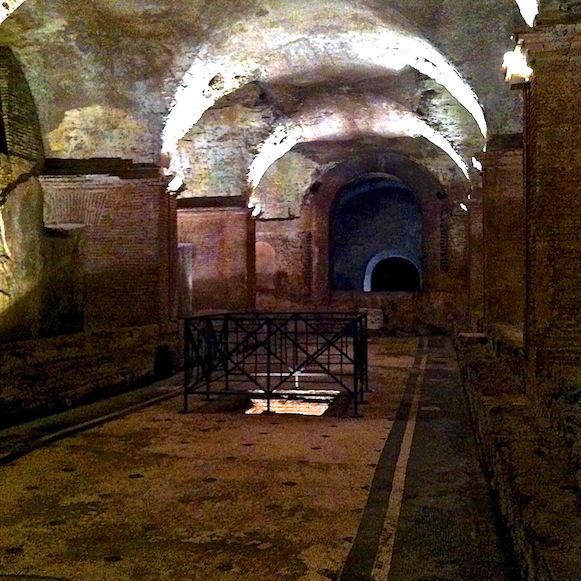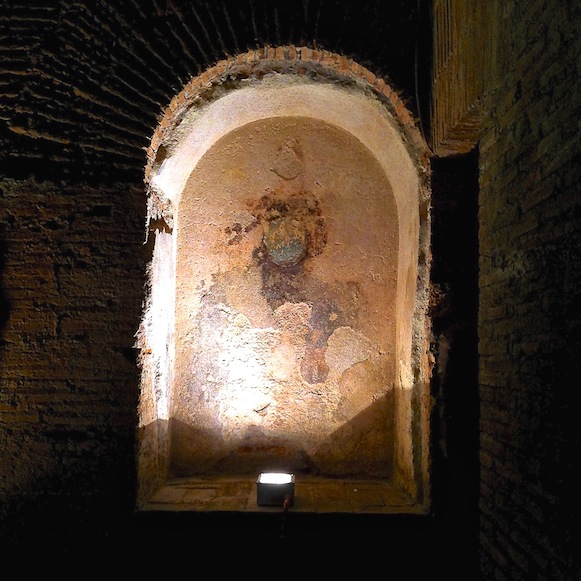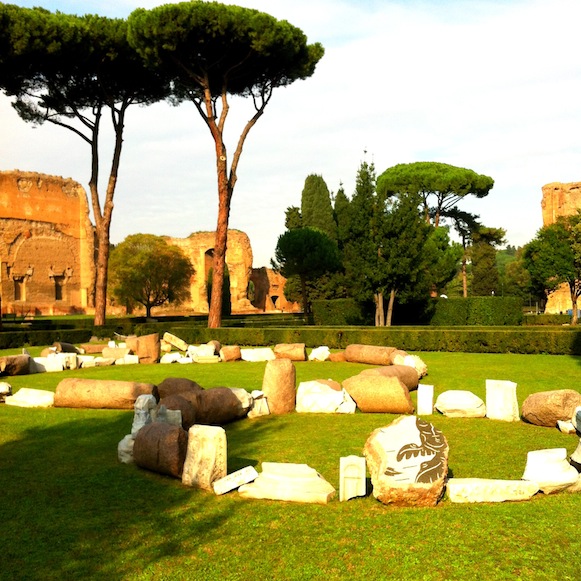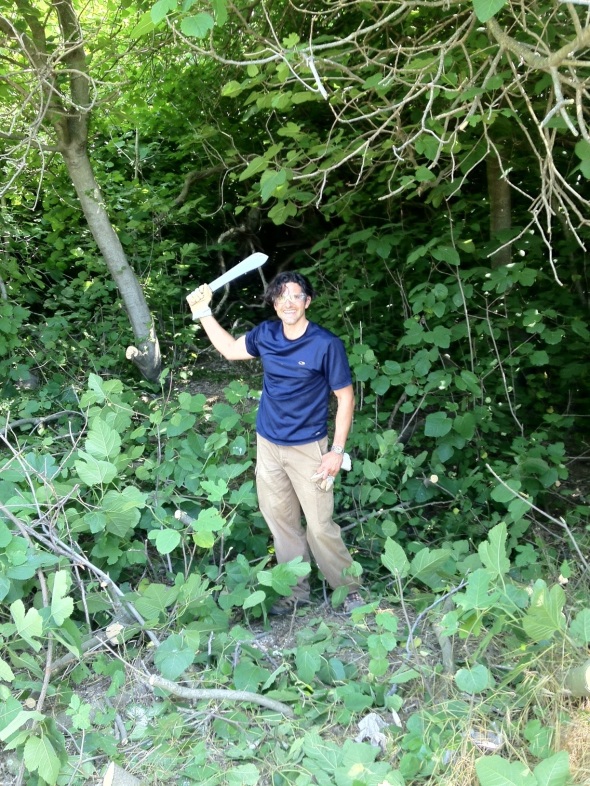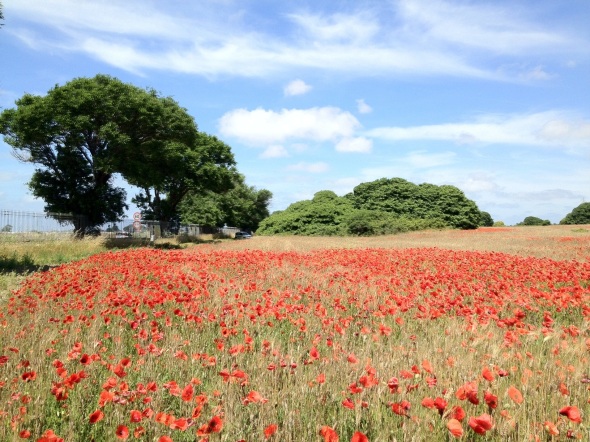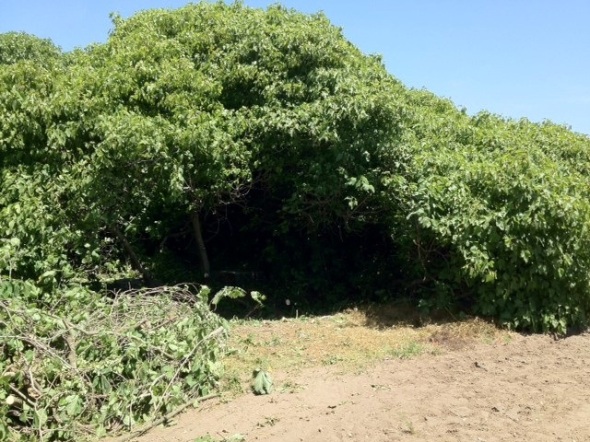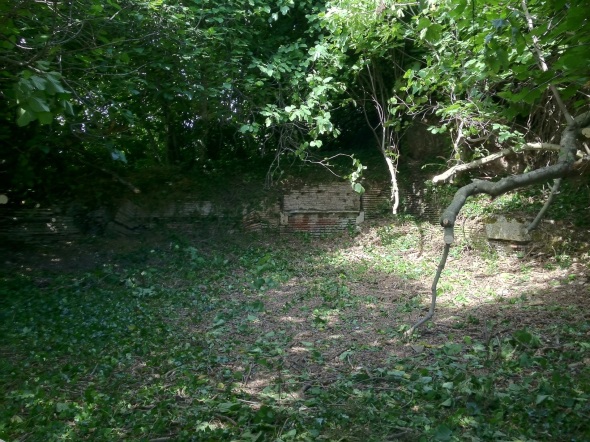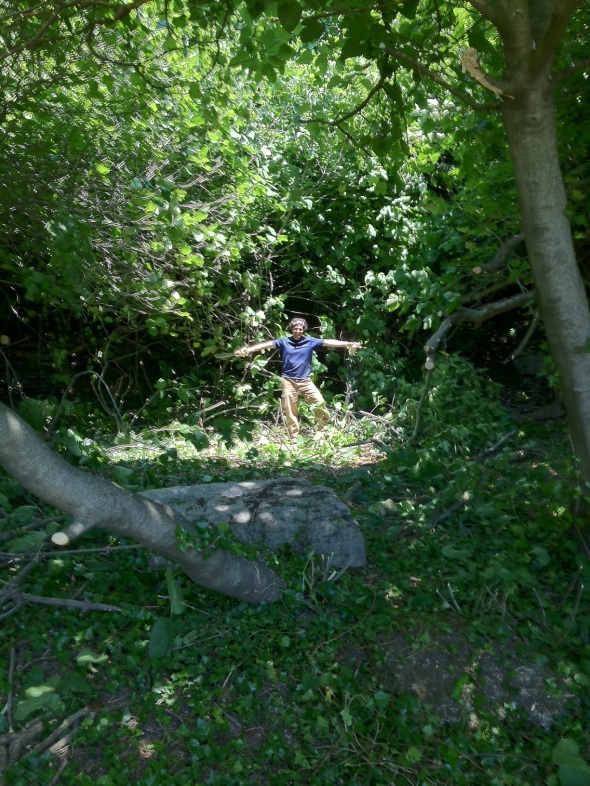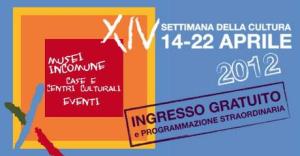Mortar and Murder: Looking Back at the 2013 Dig #archaeology
As we seek relief from Rome’s sweltering triple-digit (F) temperatures, it’s a good time to look back at six weeks of fun, hard work, and intensive learning. Here are a few things that struck me, in my capacity as Project Coordinator, about the experience.
Low injury rate. During the course of a typical season we see a handful of cuts or scrapes that require on-site medical attention, as well as a lot of first-week blisters that exhaust the supply of band-aids in no time. This year we had only one cut, thankfully, and not even one band-aid was used.
Plot twists. We started out assuming that the Roman mausoleum in Area B was, at some point after the end of antiquity, transformed into a baptistery, which was subsequently re-worked to accommodate six tombs in the Middle Ages; two bodies were duly found in one of these tombs in the fall exploratory campaign. In the summer not even one additional burial was found in the tombs, while a series of burials was revealed just below the ground surface around the edge of the mausoleum. Proof that, in archaeology, assumptions are made to be modified and abandoned.
Gastronomic adventures. This year everyone looked forward to lunch, which was prepared and served at La Fraschetta del Borgo in Ostia Antica, a stone’s throw from the site. Solideo and the staff served up 23 tasty and abundant lunches, catering to all dietary needs, including prosciutto with cantaloupe, cold cuts and cheese, rigatoni all’ammatriciana, frittata (omelette), pizza, sausage with chicory, and chicken cacciatore with potatoes. The daily dose of gelato was especially popular.
Language lessons. Every edition of AIRC’s Summer Archaeological Field School involves bilingual staff, so you can always hear both Italian and English spoken on-site. This year’s Babel had a particular feel to it. There was the lilting British accent of our Welsh topography intern, Tim Penn. There was archaeologist Larisa (“Larry”) Criscenti’s elegant and studied English. There were the participants’ gung-ho attempts to learn Italian from field director Michele Raddi’s colorful diction. My favorite moment was the attempt to explain to our Italian colleagues the subtle acoustic distinction between “mortar” and “murder.” Two very different concepts, but both very useful in a Roman archaeology field school.
– A.P.
Life in the Trenches: Week 5 at the Dig
The last week of excavation at Parco dei Ravennati was a bipolar mix of calm instruction and frenzied activity: though it was declared that we were officially finished with the actual digging, many tasks still remained to be done. After a lecture on different types of pottery and marble, we assisted Julia Elsey in the monumental task of cleaning, labeling, and recording every shard we had found this past season. Additionally, the guest lecturer Alessandra Ghelli came to give an enlightening talk on a field we all have little experience with – Marine Archaeology. (more…)
Ostia Antica Press Conference/Invito Stampa
MINISTERO DEI BENI E DELLE ATTIVITA’ CULTURALI E DEL TURISMO SOPRINTENDENZA SPECIALE PER I BENI ARCHEOLOGICI DI ROMA
La Soprintendenza speciale per i beni archeologici di Roma, con l’American Institute for Roman Culture, presenta i risultati delle più recenti ricerche effettuate nel Suburbium di Ostia antica. L’appuntamento con gli archeologi e con gli studenti di archeologia di 14 università del Nord America è fissato per venerdì 19, alle ore 10.00, all’angolo fra via dei Romagnoli e via della Stazione di Ostia antica (v. mappa).
Please join the Superintendency, along with the American Institute for Roman Culture, in the presentation of the findings of the most recent research of the Suburbium of Ostia Antica on Friday July 19 at 10 am. The conference will be held at our dig Parco dei Ravennati in Ostia Antica, via dei Romagnoli and via della Stazione di Ostia antica, see maps below. (more…)
Life in the Trenches: Week 4, 11 Things I’ve learned on the Dig
- Count the buckets: When brushing away a mound of dirt with the equivalent of a glorified toothbrush and an oversized spork, it can be discouraging to look at your area after several hours of work and feel you haven’t made a dint in it. In order to prevent dismay, learn to count the buckets of dirt that you fill instead. Nothing says progress more than being able to climb up a pile of dirt and say, “Look, Ma! I spent 5 weeks moving all this dirt from over there to over here!”
- Remember all your hard work will eventually pay off* : Excavation needs to be a slow process
Life in the Trenches: Week 3 at the Dig

Though this past week was only four days to accommodate a (well-deserved) three-day weekend, we jumped into work, comfortable with our designated roles and team coordination. We also welcomed a new team member, Julia Elsey, AIRC archaeology field school veteran and an unofficial Finds Coordinator. As an artifact intern, I work with Julia to clean, document, and organize our finds from this and the past dig seasons. Julia provided our team with a valuable lesson on marble types, (more…)
Life in the Trenches: Week 2 at the dig
Week 2 at Parco dei Ravennati takes us behind the scenes with Katherine Livingston, University of Minnesota (Twin Cities), Near Eastern and Mediterranean Archaeology major:
When people hear that I am in Rome for an archaeological dig, many comments referencing Lara Croft or Indiana Jones pop up. The adventurous and even dangerous connotation that archaeology has developed in the media is generally fictitious. So when I heard Dr. Michele Raddi refer to some of his teachings as “Survival Archaeology” during workshops I let out a small scoff. But over this week I’ve seen that while it may not be risking life or death, surviving means adapting and cooperating for the ensured integrity and success of an archeological site. (more…)
Life in the Trenches: Week 1 at the Dig
Welcome to the Parco dei Ravennati excavation in Ostia Antica. There is nothing like being on site at an excavation, and nothing better than having hands on reportage of the dig itself. Five participants have volunteered to contribute a blog post about what they are doing at Parco dei Ravennati. From now through July 21, we will feature weekly posts from the point of view of actual dig participants as they get down and dirty in Ostia Antica. Our first post is from Tara Giangrande, an art history and anthropology student from Swarthmore College.

After a week of touring around all seven hills of ancient Rome, the students of this summer’s AIRC archaeological field school began work at Parco dei Ravennati in Ostia Antica. While a few of us had prior experience with excavation, it was an entirely new adventure (more…)
Tips to Surviving a Roman Summer
It’s a strange phenomenon that always seems to baffle the locals: the highest tourist season seems to be in the sweltering depths of July and August, when the locals, at least the lucky ones, desperately escape the city for the seaside. But so it goes: with many non-locals able to take their vacation only during the hottest months of Rome weather, even as the sun blazes on, the show must go on! You can get through a trip during the “Estate Romana” too—here’s what to expect and how to make it through!
Keeping Your Cool
Lots of great suggestions abound on the web as to the best ways to keep cool. Last year we listed our top 5 tips for cooling off here. There are the usual suspects (gelato, cold water running from the street fountains throughout the city) as well as a lesser-known delight: grattachecca. But how about going high-tech for your cooling needs? You can download an app called “Water Finder in Rome” for your iPhone that shows where to find the “nasoni” water fountains, (more…)
Digging the Dig before we dig, Ostia Antica 2013
For those of you with visions of Indiana Jones and Laura Croft frolicking through layer upon layer of antiquities, here’s a glimpse at what our excavation looks like immediately before the students start digging into Ostia Antica.
Ostia Antica: The Importance of First Impressions
If you mention Ostia Antica to most anyone, Italian or foreigner, you get only a blank stare and/or a shake of the head. Most modern Romans have never visited it, at least not in their adult lives; in fact, the majority of the roughly 300,000 people who visit the site every year are Italian schoolchildren and foreign tourists. This is a tiny fraction of the nearly five million people who visit the Colosseum every year. Yet there was a time—about 2000 years ago, admittedly—when, if you mentioned the word “Ostia” to anyone who travelled, whether Roman or foreigner, you would get an animated response fueled by mental images of Rome, the greatest metropolis of the ancient world, for which this unpretentious port city was the lifeline to the world. Millions of people from all walks of life embarked and disembarked at Ostia in the approximately 1000 years of its life, from slaves to emperors (Augustus, Claudius, Nero), from merchants to early Christian luminaries (St. Augustine). These people navigated the same streets, drank from the same fountains, and washed in the same bath complexes that we can see today, just 25 minutes by train from downtown Rome.
I first “landed” at Ostia Antica as a graduate student in the summer of 1998. My initial impression of the site then still corresponds perfectly to its appearance today: a beautiful, sleepy, largely empty park packed with an incredible array of structures that beg to be explored. It’s like having a theme park practically to yourself, except this theme park happens to be the closest experience to the look and feel of ancient Rome available anywhere in the world.
Several things struck me then, as now. Ostia is as big as Pompeii, but it offers a much better visitor experience by virtue of being entirely accessible (whereas most of Pompeii is barricaded to keep visitors away), well-shaded by big pine trees, and much less crowded. The one major disadvantage that I recall was having to leave at lunchtime to forage for food in the Medieval borgo next door, an episode that nevertheless had a silver lining in introducing me to a quaint 1000-year-old town.
The food problem at Ostia Antica was soon remedied by the construction of a pleasant glass-walled cafeteria next to the site museum, which allows the visitor to spend the entire day among the ruins. The visitor experience at Ostia Antica continues to improve gradually with every passing year. Recently a cement staircase and ramp were installed on the decumanus maximus (main east-west road) at the corner of Via dei Molini to smooth the abrupt (and dangerous) drop from the Late Antique to the Republican street level, the mosaics in the Piazzale delle Corporazioni were cleaned, and Wi-Fi was installed in the cafeteria.
But if it’s true that first impressions are the most important ones, then much more needs to be done to allow Ostia Antica to make the sensational first impression every visitor deserves. There are many dirty mosaics and frescoes that need to be cleaned and conserved, collapsing walls that need to be patched up, and trees and plants that need to be cut back more frequently. Many of the informational signs are so old as to be faded or peeling, and there are not enough signs to make up for the lack of a good guidebook in English.
We at the American Institute for Roman Culture are big fans of Ostia Antica, and we’re working hard to improve the visitor experience there through a variety of projects. In 2010 and 2011 we created a series of educational videos about the site that were recently cited by The New York Times as an authoritative source. In 2011 we brought much-needed attention to the site by making it a central theme of our first annual Unlisted conference on sustainable cultural heritage. In 2011 and 2012 we tested an innovative approach to documenting and conserving the standing remains. And in recent years our Summer Archaeological Field School has been based at Ostia Antica.
In 2013 the AIRC field school will be held in the Parco dei Ravennati, a practically unexplored public park located between Ostia Antica and the borgo. This three-year excavation will help finally unite the two areas, blending the romantic beauty of Ostia Antica, the imposing majesty of the castle of pope Julius II, and the relaxing small-town charm of the borgo into an unforgettable first impression. It’s also an opportunity to engage the local community and invite them to invest their tangible and intangible resources in the transformation of Ostia Antica into a world-class archaeological experience on a par with Pompeii and central Rome through preservation, education, and promotion, so that everyone will gain something.
We want your first impression of Ostia Antica to be a great one: please consider joining the excavation project, if a student, or just stopping by to say “hi” as you make your way from the train station to the archaeological site.
– by Albert Prieto, AIRC Associate Director of Archaeology, albert[at]romanculture.org
Study Abroad with AIRC: Cal State Fresno offers School of Record to AIRC Programs
AIRC is pleased to announce the development of its partnership with California State University, Fresno (Fresno State), as official school of record for all academic program offerings. University academic credit for AIRC programs will now be offered by Fresno State. That includes our upcoming 15-week semester program:
- Fall 2013 Signature Semester Program September 2-December 12, 2013
as well as this summer’s program offerings:
- Living Latin, Living History A unique program in colloquial, spoken Latin language with Professor Nancy Llewellyn
- Layers of Rome, Track 1 History and Art History A comprehensive overview of the ancient Roman world
- Layers of Rome, Track 2 Media Studies A solid basis in ancient Roman studies for producing a real-world media project
- Archaeological Field School An intense hands-on excavation program, now in its 11th year
The partnership, which is administered through Fresno State’s Division of Continuing and Global Education in partnership with the College of Arts and Humanities, support’s the University’s internationalization vision as articulated in its Strategic Plan for Excellence. Russel Statham, Manager for Administration and Global Operations, said, “We are excited about this new partnership and are pleased to be able to expand Fresno State’s role in promoting global education. Our alignment with AIRC will offer hundreds of students the opportunity to receive academic credit for world-class educational programs in Rome, and we are pleased to be a leader supporting international education opportunities.”
AIRC is proud to have Fresno State as its official partner in offering university academic credit for AIRC’s high-quality, one-of-a-kind academic programs in Rome, and is looking forward to the opportunity to now enroll a much wider range of students who require college credit for their academic experience abroad.
Now Enrolling! Click here to view AIRC Study Abroad Programs
What’s in an Archaeologist’s bag?
 So what exactly does a field archaeologist look like?
So what exactly does a field archaeologist look like?
For most people, the term “archaeologist” conjures up the image of a stubbly man wearing a button-down shirt with pockets, chinos, a leather jacket, a wide-brimmed hat, a saddle-bag, a bull-whip, and a holster with revolver.
I’ve been working as a field archaeologist in Italy for going on 20 years now, and my appearance has never corresponded to that image—except for the stubble, which I proudly wear most days, and not out of vanity, but because my facial hair grows very slowly. I confess to having a broad-brimmed hat, a gag gift from a friend, but it’s too heavy to wear in the Mediterranean heat. Forget about a leather jacket. The pistol and bull-whip, as instruments for maintaining discipline among the crew, have been replaced by the threat of a low grade and/or no letter of recommendation for grad school.
What does a typical contemporary field archaeologist working under the Mediterranean summer sun look like? My outfit, which is pretty typical, includes:
- A slightly tattered polo shirt, symbol of my tortured relationship with bourgeois social conventions, which I respect and despise simultaneously (an attitude I call “archaeo chic”)
- Cargo pants, which allow me to carry truly ridiculous amounts of stuff on my person
- Sandals, which keep my feet from smelling any worse than they really need to
- Reinforced work boots, which keep my toes from getting any more crushed than they really need to be
- A backpack, symbol of my lifelong dedication to scholarly pursuits (or my inability to grow up and get a real job, depending on one’s point of view)
Curious about the cargos?
- Loose change for buying coffee during the day (I don’t make brilliant discoveries without caffeine)
- Chewing gum with xylitol (I don’t make brilliant discoveries when distracted by food particles in my mouth or bad breath)
- A packet of heavy-duty tissues (I don’t make brilliant discoveries with a stuffed up nose)
- Polarized Ray-Ban sunglasses (I don’t make brilliant discoveries in blinding sunlight)
- The key to the lock on the equipment shed (no one makes brilliant discoveries—or any discoveries, period—without access to tools)
- Two cell phones: an iPhone 3GS that keeps me connected to the world (and my sanity), and a bare-bones model that keeps me connected to colleagues and students (and rings continuously…)
- A mini Swiss Army Knife, for defense against irate colleagues and students
Double-strapping the backpack:
- Clipboard with pen
- Water bottle
- Sunscreen
- Baseball cap
- Trowel
- Cut-proof work gloves
- Reserve pen
- Bottle of non-aspirin painkillers
- Asthma inhaler
- Hand-sanitizing lotion
- Reserve packet of heavy-duty tissues
- Digital camera for capturing what used to be known as “Kodak moments”
- Pocket flashlight for exploring the many underground spaces of Ostia Antica
Possible addition to next year’s gear list: a hip-flask. I suspect that I might make more brilliant discoveries with one. At the least, I won’t notice the phone ringing so much…
~A.P.
Mithraeum at the Baths of Caracalla
Any time an ancient site opens, or better yet, reopens, it is a cause for celebration. Once again, we are permitted to literally step into history and equally watch as history makes itself thanks to continued cultural heritage endeavors and financial support. This is especially the case with the recent opening of the Mithraeum of the Baths of Caracalla. Originally discovered in 1912, this mithraeum is considered the largest documented gathering space for the worshippers of Mithras. (Mithras was a Persian god in vogue with the military and mostly lower class men, in the second and third centuries AD.) The mithraeum, approximately 23 meters long and 10 meters wide with a soaring cross-vaulted ceiling, can be only roughly dated by the two main events associated with the bath complex: the mithraeum was certainly created after the complex was completed in AD 217, and it was probably no longer in use when the aqueduct supplying the complex was cut during the Greco-Gothic Wars in 537. In reality, it probably went out of use long before 537, since most scholars hold that Christianity had supplanted Mithraism as a “religion for the masses” by the early 4th century.
Today, a visit to the mithraeum can be considered a brief one, as what is available to us are primarily two chambers: a small square ante-chamber and the main rectangular meeting hall. Apart from a recently-restored fresco of the god (missing the face, unfortunately – presumably hacked away by Christians), there is very little left of the decoration, which was probably very lavish. The well-preserved podium structures on either long side, on which the worshippers reclined during ritual meals, give an excellent idea of the context and purpose of the shrine. Certainly the most intriguing feature is the small tunnel that runs under the center of the main hall into an adjoining room, where there is an entrance/exit with staircase; this has been identified with some controversy as the fossa sanguinis, the ritual pit over which the bull at the center of the Mithraic mythology was slaughtered, bathing one or more initiates in its blood.
Its location, off a dirt road adjacent to the main entrance, is part of a subterranean area of the Baths of Caracalla. The mithraeum space is just one part of the massive, sprawling system of underground corridors that honeycombs the large artificial platform supporting the Baths of Caracalla. Beneath the thermae complex lies a warren of tunnels with furnaces, stoked by slaves, and storage areas for supplies, including wood. Though access to these tunnels is today only partial, there are confirmed plans to extend the conservation and restoration work to make more of these areas accessible, including a substantial area dedicated to grinding grain using the water that passed through the baths.
It is important to note that Rome and its port city Ostia Antica have the largest number of preserved mithraea of any city in the Roman empire—scholars estimate that Rome once had 700 Mithraic shrines, while Ostia boasts 17 confirmed shrines—but only a small percentage of these are accessible to the public. More money and more investment will only benefit conservation and access for tourists who are increasingly willing to explore the more remote corners of the ancient city.
Visiting the Mithraeum is also an excellent excuse to head into the Baths of Caracalla to walk among the monumental structure and also enjoy a contemporary art installation by Italian artist Michelangelo Pistoletto. Three interlocking circles made up of fragrments of ancient marble and stone, Terzo Paradiso is the new symbol of infinity created by Pistoletto originally for the 2005 Venice Biennale, and an ongoing, collaborative project in varying venues and media. The new infinity symbol is all to action for the active and conscious need to create a “third paradise” to combat and transplant the artificial world we are celebrating today. Too deep? Too artsy? In any case, the site specific installation (through January 6, 2013) is a beautiful juxtaposition of contemporary and ancient, especially with the backdrop of the majestic pines and Baths of Caracalla.
How to visit: advance reservation for a guided tour to Mithraeum at the Baths of Caracalla will cost 16.50 euro and does not include entrance to the Baths. Here’s a tip- try the unguided visits at 10:00, 10:30, and 1:00, which are practically empty on weekdays. How? Buy the regular ticket (6.00 euros) at the ticket booth and pay a 1.50 euro supplement to visit the Mithraeum at one of those three times.
Summer Lovin’ happened so fast

This is the last week of the Summer Field School at Ostia Antica Tor Boacciana. We can’t believe how fast time has flown as we document the past. Here is a sampling of beautiful amazing photos taken on site by Selma Amzi, 2012 Field School Photography Intern. Please take a look at our Flickr collection while on site, as well Facebook.

Dig Rome: Ostia Antica 2012 has begun!


They have arrived! Ostia Antica Summer 2012 Excavation group is ready to get dirty! This week, we will be visiting several sites and monuments in Rome so please take a look at our twitter feeds: @AIRomanculture and @SaveRome (as well as instagram), and hashtags: #digrome #ostiaantica12. 
Half of our OstiaAntica 12 students taking a stroll in the Roman Forum.
Heatwave Rome: Our top 5 tips to cooling off in the summer
Welcome to Rome in the summer. One word: hot. And imagine working in the dirt eight hours a day every day under a full sun. Since we’re always thinking about the well-being of our students, we’ve come up with five fool-proof tips to cooling down during the urban heat. If you think you (or anyone you know) will break from Rome’s rising mercury, here’s how we do it:
- Grattachecca(grah-tah-KEK-ah)

- This is Italian shaved ice– aka the real deal. Literally shaved by hand on the spot from a big block of ice, grattachecca is a Roman summer tradition where you get to pick the fruit syrups and fresh fruit to pour into the hand-shaven ice. Grattacheccha stands are street-side kiosks, and sometimes are near the summer sliced watermelon pop-ups. Our favorites include:
- Sora Mirella Lungotevere degli Anguillara, corner of Ponte Cestio (Trastevere)
- Fonte d’Oro, Piazza G.G. Belli (Trastevere)
- La Grattachecca Piazzale di Ponte Milvio (Flaminio/Ponte Milivo)
- This is Italian shaved ice– aka the real deal. Literally shaved by hand on the spot from a big block of ice, grattachecca is a Roman summer tradition where you get to pick the fruit syrups and fresh fruit to pour into the hand-shaven ice. Grattacheccha stands are street-side kiosks, and sometimes are near the summer sliced watermelon pop-ups. Our favorites include:
- Ostia Beach
- Since our excavation is at Ostia Antica, instead of saying “take a hike”, we tell our students to hit the beach. A half-hour local train from Rome (on the same line as heading to our dig site), is Ostia beach- a public beach with restaurants, activities and social life. For your €1.50 ATAC ticket, hop on Roma-Lido “trenino” (little train) found at the local station adjacent to the Piramide (Metro B) metro. Destination: Lido Centro.
- Use a big nose
- That’s right, those fountains you see on the streets that are constantly running are called “nasoni,” big noses, and they are a really great way to keep cool and hydrated as you explore the city. The water is cold, clean and delicious, coming from a deep underground spring. According to the Comune di Roma, the nasoni run constantly in order to keep the system clean and flushed out. Our tip to taking a sip? Put your finger over the main spigot to block it and water will arc out of the small hole on top. Or, you can use them to fill your water bottle without paying outrageous tourist prices for water bottles at the coffee bars! Newsflash: the Comune di Roma is offering re-useable water bottles sold for €2 at local tourist information points (PIT).

- That’s right, those fountains you see on the streets that are constantly running are called “nasoni,” big noses, and they are a really great way to keep cool and hydrated as you explore the city. The water is cold, clean and delicious, coming from a deep underground spring. According to the Comune di Roma, the nasoni run constantly in order to keep the system clean and flushed out. Our tip to taking a sip? Put your finger over the main spigot to block it and water will arc out of the small hole on top. Or, you can use them to fill your water bottle without paying outrageous tourist prices for water bottles at the coffee bars! Newsflash: the Comune di Roma is offering re-useable water bottles sold for €2 at local tourist information points (PIT).
- Villa Borghese
- Rome’s second largest park with over 140 acres of greenery is the perfect respite from a hot day in the sun. You can walk up from the stairs off of Piazza del Popolo, take a paddleboat, peddle around on a group bike, rollerblade or run under the sprinklers.
- Gelato
- Saving the best for last, don’t forget to sample Roman gelato, which is definitely NOT ice cream. Gelato uses more whole milk and less cream, so it has a lower fat content, and it contains less air so it’s denser which provides a more intense flavor. Some of our favorite gelato shops are*:
- Gelateria Corona, Largo Argentina 27 (Campo de’ Fiori)
- Fior di Luna, Via della Lungaretta 96 (Trastevere)
- Gelarmony, Via Marcantonio Colonna 34 (Prati)
- Frigidarium Via del Governo Vecchio 112 (Piazza Navona)
- Gelateria del Teatro Via di San Simone 70 (Piazza Navona)
- Saving the best for last, don’t forget to sample Roman gelato, which is definitely NOT ice cream. Gelato uses more whole milk and less cream, so it has a lower fat content, and it contains less air so it’s denser which provides a more intense flavor. Some of our favorite gelato shops are*:
So you think you want to be an archaeologist? Ostia Antica 2012

Here’s what we have in store this summer…
Living History in Rome day by day
Take a peek into the mind blog of AIRC Executive Director Darius Arya as he writes about
Living History in Rome day by day.
Life in the Trenches: Romesick

Potential student excavators beware! If you go with AIRC to dig in Ostia, you WILL feel “Romesick” as soon as you leave!
I participated in AIRC’s Ostia field school two summers ago, and my time in Rome still affects who I am today. I now conduct my discipline of art history/archaeology as well as my life differently because of having learned and lived in this unique environment.

Ostia Antica is a fantastic site to excavate. It seems like it is always a work in progress, with other field schools and preservation projects occurring at the same time as AIRC’s dig. As an excavator, you are part of the process that creates and shapes how tourists and historians will perceive Ostia. Every time you sink your pickaxe or shovel into the ground, you are technically determining how the future will understand the ancient past!! Every day it felt so satisfying to walk back to the train station with everyone, covered in dirt from a hard day’s work and thinking about what laid in store for us tomorrow.
By the end of the six weeks, I loved all of the amazing friendships I made and how much I learned about myself. I still keep in touch with the other USC students who went on the dig with me, as well as many of the non-USC students too. I got to know and learn from Professor John Pollini and the AIRC staffers, and they all have been incredible mentors and teachers to me. I loved the independence and confidence I gained from living in Rome, being able to wander around on the weekends and late afternoons casually exploring the city. I really felt that I knew Rome like a local, like it had always been my home.
 Even after two years, my time in Ostia with AIRC continues to aid my eagerness to learn. I went on another dig this past summer, and it was great to already have some excavation knowledge (and impress the field school’s staff with it!!). I could immediately participate in more complicated activities like field surveying and artifact conservation because AIRC gave me a great foundation in proper excavating, preserving, and cataloging techniques. They provided a well-rounded introduction to field archaeology that expanded my future opportunities.
Even after two years, my time in Ostia with AIRC continues to aid my eagerness to learn. I went on another dig this past summer, and it was great to already have some excavation knowledge (and impress the field school’s staff with it!!). I could immediately participate in more complicated activities like field surveying and artifact conservation because AIRC gave me a great foundation in proper excavating, preserving, and cataloging techniques. They provided a well-rounded introduction to field archaeology that expanded my future opportunities.
If you aren’t scared of getting dirty, actively shaping Roman history, and living abroad for a summer, then AIRC’s Ostia field school will be a fantastic experience! My time in Rome changed me, and since then I have truly looked at life and the ancient past in a different and exciting way.
~ Alexandria Yen, SAFS ’10, will receive her B.A. in Archaeology and Art History from the University of Southern Californiain 2012
Life in the Trenches: An Excavation’s Top 5

~Nadia Pucci SAFS ’11 (Sant’Omobono) shares with us her top five things you really need to know when working on an excavation in Rome:
-
 Sun screen, water, and gloves: Sun protection is essential, especially in the more intense Italian heat. Water is also important for staying hydrated. Lastly, gloves are a must to prevent blisters from all the troweling.
Sun screen, water, and gloves: Sun protection is essential, especially in the more intense Italian heat. Water is also important for staying hydrated. Lastly, gloves are a must to prevent blisters from all the troweling. 
- Whatever you do, don’t bring: any valuable possessions, leave them at home! You don’t want to risk possible damage or loss of the items(s). Try not to bring your entire house with you to Italy, just bring the essentials since you will end up acquiring several items during your stay that you will have to haul back.
- The good and bad about working/living in Rome: Living in Rome means easy accessibility to various sites – mostly within walking distance – as well as the endless amount of pizzerias and gelaterias. The people and culture can be experienced even while taking a simple stroll to the piazza. There aren’t many words that can be used to accurately d
 escribe the endless possibilities that Rome has to offer, but “priceless” will suffice. One not-so-good aspect is transit. The buses can be a little unpredictable! Their bus stops are different from what we know and understand, and there are strikes which shut down most transport mechanisms for a few hours.
escribe the endless possibilities that Rome has to offer, but “priceless” will suffice. One not-so-good aspect is transit. The buses can be a little unpredictable! Their bus stops are different from what we know and understand, and there are strikes which shut down most transport mechanisms for a few hours. - What to do in your spare time: With free time, I loved to venture and explore. From visiting Castel Sant’Angelo and the Vatican to walking alo
 ng the Tiber at night under the moon and lights from the busy night markets. Of course, going to beach and swimming is a splendid way to beat the heat
ng the Tiber at night under the moon and lights from the busy night markets. Of course, going to beach and swimming is a splendid way to beat the heat - Who are you- aka Dig Personality: It’s hard to state one dig personality, because I feel that I experienced several at any given time. I definitely think that I was a cheerleader, encouraging my peers to continue troweling. And I do think that ov
 er time I became a wheelbarrow warrior! At first I was slightly afraid of the dreaded task of unloading the wheelbarrow, but by the end of the dig I was able to unload it with little or no help! Lastly, dirt magnet is an obvious personality for most people, especially myself, since no matter what the day’s tasks were I seemed to always be covered in dirt from head to toe. It was a challenge to stay clean during the dig!
er time I became a wheelbarrow warrior! At first I was slightly afraid of the dreaded task of unloading the wheelbarrow, but by the end of the dig I was able to unload it with little or no help! Lastly, dirt magnet is an obvious personality for most people, especially myself, since no matter what the day’s tasks were I seemed to always be covered in dirt from head to toe. It was a challenge to stay clean during the dig!
Life in the Trenches: An Augustan Experience

 If my summer digging with AIRC in Ostia were a Roman Emperor, it would have to be Augustus. Not only was it the best summer ever, but it was also a time of personal and academic growth, development, and expansion.
If my summer digging with AIRC in Ostia were a Roman Emperor, it would have to be Augustus. Not only was it the best summer ever, but it was also a time of personal and academic growth, development, and expansion.
I had worked for a few seasons on a dig near my hometown in New England, and, as an archaeology major, had always dreamed of working in Rome and gaining experience in Mediterranean field archaeology. In terms of skill building, I couldn’t have asked for more. While we spent most of our time digging, there was plenty of time spent getting acquainted with the ins and outs of artifact washing and cataloging, archaeological drawing, wall profiles, and surveying with a Total Station. In short, it was a complete field experience. My favorite times were spent swinging a pickaxe like I had a vendetta against the topsoil, but I am grateful for getting to develop my skills in other areas of fieldwork. 
There’s nowhere else to dig quite like Ostia. While still part of Rome, it’s quiet and idyllic; like digging in your neighborhood park (if your neighborhood were 2,000 years old and had a forum built by Tiberius). Since Ostia is often overlooked by tourists, it will feel like it’s your own. For all that, it’s only a 25 minute train ride from the center of Rome. Living right in the centro storico was an unbelievable experience, and I would happily spend my evenings and weekends exploring the little stone-paved streets and parks, or even traveling further afield throughout Lazio. To live in such a city, even for a summer, will challenge and excite you every day.
Ultimately, a field school is only as a good as the people who are part of it. There is so much to learn from the combined knowledge and years of experience of the AIRC staff—even if that means being repeatedly told “No Jonathan, that’s just another pretty rock.” I was surprised to find that many of the other students were not Archaeology or Classics majors, but quickly saw that just about everyone shared my enthusiasm for the subject matter and the work we were doing. We bonded right away, cooking together in our apartments and trying to figure out who was the sweatiest and filthiest on the train ride home. My trenchmates and I are still in touch.
When you sign up for the AIRC’s field school in Ostia, , you are signing up for more than archaeological skills and experience. You will leave with new friends and a unique experience under your belt that will give you a new way of looking at the world. I certainly came out the better for it. As Augustus himself said:
Ostia archaeologatorem marmoreum relinquit, quem geekum latericium accepit.
 ~ Jonathan Migliori, SAFS ‘10, is graduate of Brown University 2011 and will receive his M.A. from Durham University in 2012.
~ Jonathan Migliori, SAFS ‘10, is graduate of Brown University 2011 and will receive his M.A. from Durham University in 2012.
Settimana della Cultura: Play the Culture Week Game
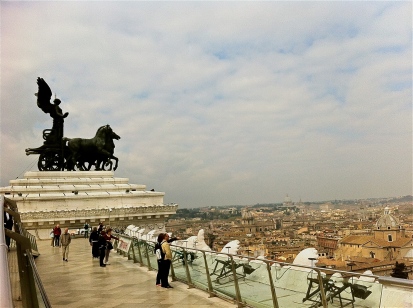
Good morning, Rome! Set your alarms early for Saturday April 14th because you’re about to play Culture Week, 8 interactive days of free cultural sites, monuments and museums through out the Italian peninsula and islands. Okay, it’s not really a game, more an incentive by the Ministry of Culture to get people– whether locals or tourists– off the caffe chair and into a museum. However, a few years back, I invented a little healthy competition with some culturally enhanced friends where Culture Week meant we would voraciously visit every museum we’ve ever desired, yet not necessarily had the wallet to finance. At the end of the week, we’d throw down our free entry tickets much as much intensity as Patrick Bateman in the infamous business card scene (at 1:29), and winner literally took all.
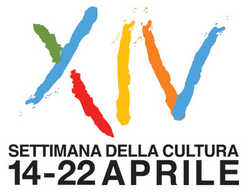 So as not to confuse, Culture Week is primarily for state-run cultural sites and also includes events such as organized concerts and performances. Yes, there is a bit of a groan because the Colosseum/Roman Forum ticket is deliberately excluded from the free entrances this year. However, that double-header ticket seems a reasonable price to pay if everything else is free and Italy is trying to save some pennies culturally. For Lazio and Rome Culture Week info: take a look at this list of free sites/events in the Region of Lazio . In addition, Comune di Roma (City of Rome) organizes events (other local governments do as well). For information about civic museums participating in Culture Week, visit Musei In Comune, and also click here for event listings.
So as not to confuse, Culture Week is primarily for state-run cultural sites and also includes events such as organized concerts and performances. Yes, there is a bit of a groan because the Colosseum/Roman Forum ticket is deliberately excluded from the free entrances this year. However, that double-header ticket seems a reasonable price to pay if everything else is free and Italy is trying to save some pennies culturally. For Lazio and Rome Culture Week info: take a look at this list of free sites/events in the Region of Lazio . In addition, Comune di Roma (City of Rome) organizes events (other local governments do as well). For information about civic museums participating in Culture Week, visit Musei In Comune, and also click here for event listings.
Are you ready to play the Culture Week game? Though the only rule is to get yourself into as many museums as possible, here are some guidelines to racking up as many points as possible:
- Accumulate points by . . . Visiting as many sites as possible and document– photos, instagram, twitter, who cares
- Get Bonus lives by . . . visiting off-beat, unknown and out-of-zone sites like a trip changing visit to Caserta, or listening to a concert at the Casa del Jazz.
- Lose a Life by . . . not paying attention. Some cultural attractions are privately financed and not subject to the free entrances as deigned by the Ministry of Culture.
My plans? Well, life isn’t always about the ancient so expect to find me traipsing about the Museo Napoleonico, enjoying some modern sculpture at the Museo Manzu, investigating Teatro Argentina, or finally figuring out what the Museo Pietro Canonica is all about.
Life in the Trenches: What to expect– the good, the bad and the dirty
 At the site of Sant’Omobono, located beside the Tiber in downtown Rome, lie the massive stone remains of a Roman sacred area with twin temples and altars from the 6th century BC dedicated to Fortuna and Mater Matuta.
At the site of Sant’Omobono, located beside the Tiber in downtown Rome, lie the massive stone remains of a Roman sacred area with twin temples and altars from the 6th century BC dedicated to Fortuna and Mater Matuta.
For five epic weeks it was my home, a place where I wielded pick-axe, shovel, trowel and dirt-filled wheelbarrow on a daily basis, sifted through dirt, washed pottery, heaved massive stone blocks of the site’s ancient Roman wall, and learned about archaeology.
Though every day I came home covered in dirt, and on one funny day even with my pants ripped in the crotch area (if you shovel with too wide of a stance in pants that are even slightly tight, the pants will stretch and rip and your boxers will be revealed to gazing tourists, as mine were!), with the work I got to carry out on this dig, the  great amount learned (and discovered) in so short a time, as well the great bonds of friendship I forged, I am extremely grateful to the AIRC and University of Michigan Prof. Nicola Terrenato for this experience, especially as it was my first experience in the field.
great amount learned (and discovered) in so short a time, as well the great bonds of friendship I forged, I am extremely grateful to the AIRC and University of Michigan Prof. Nicola Terrenato for this experience, especially as it was my first experience in the field.
Things to brace yourself for:
- Hard physical labor, every day for weeks! Some days you will find yourself so fatigued that you come home and just pass out.
- Getting up early, five days a week (but if you get to the site early, you can have a quick cappuccino, making the process easier).
- Filling out database forms
Things to look forward to:
- Hard physical labor, every day for weeks! You’re going to use a pick-axe regularly, and honestly nothing feels better than having the power to smash your way through walls of dirt and rock. Wheelbarrowing heaps of dirt regularly, heaving broken stone bits, and using a shovel will have you in excellent physical shape when you get home.
- Having the opportunity to live and furthermore, work, in the center of Rome! You can check out great sights and restaurants during your free time at night (or perhaps in the morning if, like me, you like to go running).
- Making some really good friends with the people at your dig site. By spending hours beside these people day after day, the bonds will strengthen enough that you will find yourself spending your free time hanging out with the same people after hours, playing soccer, hitting bars, playing guitar, or having fine meals.
- Getting the chance to discover some really cool Roman stuff and excavate at a phenomenal site. Since I relished smashing apart dirt and walls with a pick-axe (so much so that Professor John Pollini nicknamed me “Demetrius Poliorcetes,” Demetrius the wall-destroyer), heaving wheelbarrows, and carrying massive pieces of stone from one side of the site to the other, I can definitely say my dig personality was BEAST OF BURDEN.

~ Bryn Coleman is an Ancient History and Classics major at Rutgers University. He reflects on Summer 2011′s archaeological field school at Sant’Omobono for Life in the Trenches.
#DigRome Part 2: Field school tweet up

 With our upcoming Summer Archaeological Field School (June 18 to July 29), we hosted an excavation/life in Rome tweet last Wednesday March 28th AIRC, so that past and present SAFS participants could talk about what goes on a dig, what to expect and what not to expect. For those who were unable to meet up, we will be hosting a second #DigRome tweet-up on Wednesday, April 4, at 5pm EST/ 2pm PCT. Here’s your opportunity to ask questions about our excavations and learn what’s its like to live in Rome for the summer
With our upcoming Summer Archaeological Field School (June 18 to July 29), we hosted an excavation/life in Rome tweet last Wednesday March 28th AIRC, so that past and present SAFS participants could talk about what goes on a dig, what to expect and what not to expect. For those who were unable to meet up, we will be hosting a second #DigRome tweet-up on Wednesday, April 4, at 5pm EST/ 2pm PCT. Here’s your opportunity to ask questions about our excavations and learn what’s its like to live in Rome for the summer
When: Wednesday, April 4 at 5-6 PM EST (2-3 PM PST, 11-12 AM in Rome, 8-9 AM in Sydney)
Host: American Institute for Roman Culture
Where: Twitter: Search for hashtag #digrome
How: Check out our customized TweetGrid to send tweets. (You will need to bookmark the tweetgrid page and login with your Twitter account when ready to tweet.) Follow the #digrome hashtag, guest host Julia  Elsey on @AIRC_Guest and @AIRomanculture. Or load your Twitter page and search for #DigRome for the 60 minutes of the event.
Elsey on @AIRC_Guest and @AIRomanculture. Or load your Twitter page and search for #DigRome for the 60 minutes of the event.
Participate: Send us questions/comments in advance so that we can feature them. During the tweetup, get chatty and make sure to use the hashtag #DigRome in your tweets so everyone can see your question, answer, contribution, etc.
Not on Twitter?: You can still use the TweetGrid to follow the conversation. Though you will not be able to contribute to the discussion, you can follow all commentary.
For more information, please contact: @AIRomanculture, email: info@romanculture.org
Photo by mashable, and yes, everyone on the dig looks like that.

